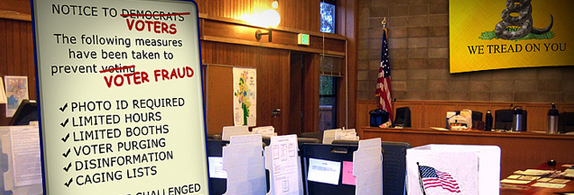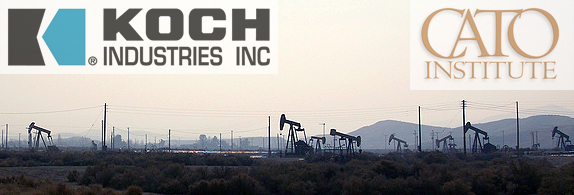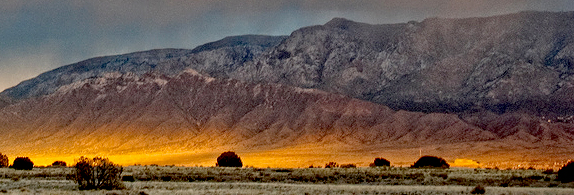Voter Anxiety: Voter Suppression

Voter fraud in the United States is virtually non-existent. That’s what a Department of Justice study showed after examining votes cast for federal candidates from 2002 to 2005. Out of some 197 million votes only .00000013 percent of them, by actual count 26, were considered fraudulent in the sense that they resulted in convictions or guilty pleas.
Voter suppression, on the other hand, intimidates and worries millions of voters every year. And the chief reason for troubling voters is that desperate Republicans have turned so-called voter fraud into a national epidemic. They fraudulently turn a non-existent problem into something that might keep some voters away from the polls. That’s called voter suppression.
It’s one of the latest forms of the old game of “dirty tricks” that started with Watergate and has infiltrated the GOP from top to bottom, creating a party that is willing to do anything they can get away with to win an election.
Voter suppression can be accomplished by many means such as poll taxes in many disguises, literacy tests, constantly changing polling places, requirements that people verify their identity with government issued IDs like a driver’s license or, as the Kansas GOP is trying right now, requiring a birth certificate or a passport to register to vote.
Anything that makes it harder to vote, any difficulty, any distortion of reality, any trivial barrier, anything at all that purposefully keeps a voter harried or worried or intimated and away from the polls is voter suppression.
Most ways to shut voters out are designed to limit or end the electoral rights of people living on the economic margins of society, people who have lost their mobility because of age but not their brains, and people who work 80 to 90 hours a week and don’t have time for monkeyshines and political trick or treats. And, lest we forget, college students.
In a real democracy voting should be as simple as decision making should be thorough. Nothing should get in the way of either.
When I first started voting in local elections in 1961, I walked into my polling place, which stayed at the same location more or less for decades, went up to the table, told the nice polling official my name, whereupon she looked it up on the voter rolls, found it, asked me to sign my signature, and then gave me a number to hand to another polling official.
It was a clean, friendly process. A signature was enough. And because the polling place was the same election after election, you got to know the officials and they became familiar with you. It was a neighborhood interaction with almost no anxiety involved.
It was as democracy is meant to be, as natural as being a citizen.
But these days there’s serious anxiety involved in voting, anxiety induced to breed uncertainty and hesitation, anxiety designed to keep citizens off guard and more worried about how to vote than about the vote itself.
We hear that about 186,000 voters are getting postcards from the New Mexico Secretary of State’s Office designed to see if they are really voters at all, rather than cadavers and vanished residents. The euphemism used for this mailing is “updating voter rolls.” It’s a stupid clerical exercise designed to trouble folks and string them out with doubts. Who cares if the voter rolls are out of date if the non-existent voters don’t vote. And because voter fraud is so extremely rare chances are “they,” whoever they might be, won’t show up.
Of course they have to do this mailing right now before the big elections in November. Now’s the perfect time to muddy the waters.
Folks are ill at ease about these postcards coming their way. I am too. Will the Secretary of State’s post card get tossed by accident, or lost in the mail, will it end up in a pile of junk mail? Will dedicated voters be purged from the rolls if they don’t do exactly the right thing in filling out the card. Will it be hard to tell if it’s exactly the right thing that we’ve done? When are they supposed to arrive? Have we missed them already? And how do we know?
Why do this at all? There can’t be any other reason but to make voters uneasy, even a bit tremulous, perhaps even skittish enough not to vote.
In the old days, if you didn’t vote for a number of elections you were automatically dropped from the rolls, at least in Bernalillo County.
We’ve all heard about shenanigans in certain New Mexico counties, where sheep were registered to vote, and the like, or vote counts were delayed, or paper ballots misplaced. But that was peculiar to those counties, not to everyone in the state.
As of 2012, to vote in Albuquerque city elections you have to show an acceptable identification – a driver’s license, a student ID card, credit or debit card, insurance card, city-clerk issued ID, or other cards with a voters name and photograph.
But what about folks who don’t have an ID because it expired, or they lost it? This can happen to people of any age, but particularly to those over 75 who must renew their license very year. Do you know how much work it is to get a substitute license, or a city-clerk issued ID if you don’t have a car, if you’re walking or riding the bus, or trying to get there after work or on a lunch break?
Even if you add just one more element into what should be a simple, straightforward civic act, you can turn it into a bureaucratic nightmare that might dampen the spirits of even the most ardent voter who’s fallen on hard times.
Any complication causes worry. Worry is like a little fence, with no gate, that must be scaled. I suspect that too many of us, worn out already from working minimum wage jobs, could find that just one more effort beyond one’s strength and means.
That’s how voter suppression works.
Sagebrush Rebellion Redux

During an election season one hears all kinds of odd rumors. In the race for State Land Commissioner we hear of big Texas money pouring in to support the Republican candidate in the hopes that he will somehow champion the old worn out ideas of the Sagebrush Rebellion in l970s and l980s. While a state land commissioner has little to do with federal lands, other than to make deals for exchanges or transfers of federal for state lands, with some sales and purchases thrown in, there’s little doubt that a Republican land commissioner would be a spokesman for efforts to turn New Mexico into a state that works to strip itself of federal public lands – national forests, national parks and monuments, wilderness areas, Bureau of Land Management land, Bureau of Reclamation land – and privatize them.
Such an official would be especially dangerous if the GOP wins the governor’s race and becomes the majority in the state House of Representatives.
The notion of doing away with federal public land is the bedrock of the old, and currently reviving, Sagebrush Rebellion. Aubrey Dunn is the Republican challenger of incumbent State Land Commissioner Democrat Ray Powell. Dunn calls Powell an “environmental extremist.” He uses state lands for solar and wind power operations. He tries to make sure that oil and gas pumping, with its huge revenue pouring into New Mexico’s schools and universities, is done as cleanly as possible. He’s concerned with watershed management and disease control in rodent populations. If Powell is an environmental extremist, every environmentalist in the state must be one too, me included. I’m proud to be in such good company.
But the Sagebrush Rebellion is not to be snickered at. The editorial board at the Los Angeles Times wrote about an effort in April of this year in which “50 political leaders from nine Western States gathered in Salt Lake City… to discuss plans to wrest control of millions of acres of public lands from the federal government.” The Times headline read: “Just what we don’t need: A new Sagebrush Rebellion.” “One wonders whether, like a dog chasing a car, they’ve figured out what they would do with the land if they got hold of it? In any case, that’s unlikely to happen, based on decades of court battles and settled law,” the LA Times concluded.
Unlikely or not, the Sagebrush Rebels know exactly what they’d do. They’d turn our national parks, forests, monuments, grasslands and wilderness over to Disneyland, McDonalds, Exxon, the Koch brothers, and the like. They’d privatize it and take it away from public scrutiny as best they could so some ricos could make a fortune out of it.
When you privatize a public property you basically make it immune to political oversight and place the safeguarding of its public purposes into the hands of regulators whose attempts at protecting the public good would be challenged at every turn in the courts and, on the grounds of proprietary private interests, trumping the public good.
The Cato Institute, a libertarian think tank, knows what to do with those lands. It offers “a blueprint for auctioning off all public lands over 20 to 40 years.” The Cato Institute maintains that, “Both environmental quality and economic efficiency would be enhanced by private rather than public ownership. Land would be auctioned not for dollars but for public land share certificates (analogous to no par value stock certificates) distributed equally to all Americans.”
This is really a preposterous idea. Public lands would not only be privatized, but their management would be ruled by majority share (or certificate) holders. Decisions would be made at what amounts to stockholders meetings. And because corporations are “persons” with virtually equal rights as human persons in the eyes of the law, as determined by the conservative majority on the Wall Street Supreme Court, they would be able to purchase certificates from the rest of us because they “could be,” the Cato says, “freely transferred at any time.”
Instead of saying that Cato and others favor “privatizing” federal lands, we should say they favor the “corporatization” of federal lands, lands that now belong to all of us but would soon belong to big business, both those residing and paying taxes in this country and those in hinterlands of international finance far, far beyond our control, as with companies in China.
Imagine going to Chaco Canyon and finding it to be “economically efficient” in the eyes of the majority of “certificate” holders to turn it into an archaeological amusement park, with hotels, restaurants, and paved roads, and fracking sites doing their business on private parcels right next to it. The Sagebrush rebels are the folks who’d like to see the trails widened and paved into the Grand Canyon so people can get down in golf carts or snazzy little sports cars. They’d also be happy with uranium mines on the rim of the canyon.
Privatizing and corporatizing public land is not a fringe idea in the Republican Party. The administration of Ronald Reagan tried to privatize some federal lands in the l980s. George W. Bush proposed a Cato Institute approach to auctioning off some 300,000 acres in 41 states. The Sagebrush Rebels are mainstream Republicans through and through.
The race between Democrat Ray Powell and Republican Aubrey Dunn for State Land Commissioner is more important than it might seem. It’s a choice between a person who calls public lands a kind of failed socialism and a person who sees public lands as one of the great democratizing and ecologically sound ideas in the history of American and New Mexican politics. This election contest really is much more important that it seems at first glance.
Why We Love New Mexico: The Sandias

When you return home to Albuquerque, you instantly see one of the major reasons why we love New Mexico so much. There on the eastern skyline are the Sandia Mountains, majestic remnants of an unthinkably violent geological event that both uplifted them from the depths and created the Rio Grande Rift which started some ten million years ago.
The Sandias are but one example of the overpowering nature of New Mexico’s geologic marvels. Be it Mt. Taylor, Shiprock, the Cerrillos Hills, the San Pedros and the Ortiz, the Sangre de Christos, the Florida Mountains in Luna County, or any of a hundred other striking landscapes, New Mexico always gives those of us who love it an exhilarating, and yet humbling, sense of amazement and joy.
If you live in the Rio Grande Basin, the Sandias mark your home place. Driving to Albuquerque on 550 from San Ysidro, for instance, the Sandias literally explode from the realms of perspective – a mythological mountain, a stoic storm wave of granite. It seems so huge that it really does hold up the clouds, and then, as the road dips and turns, the mountain wave vanishes without a trace and then reappears as if it were a wing of stone, the fossil conveyance of an ancient god of the land.
Topping out at 10,678 feet, the Sandias always seem to me to be still rising up out of the great rift that their emergence helped form. The heart of the mountain is made of Sandia granite with its crystals of potassium-feldspar that at dusk can give the mountains its watermelon color. Having been uplifted from immense depths as the pressures of colliding tectonic plates shifted to form the Rio Grande Rift, Sandia granite is around 1.5 billion years old. It’s combined with other metamorphic rock that’s nearly 2 billion years old and capped with a 300-foot layer of limestone and sandstone laid down by ancient seas. The age of the earth itself is nearly 5 billion years. So Sandia granite was formed at about the midpoint of the planet’s geologic evolution.
Sometimes landscape mirrors desire. The Sandias rising up from the magma below reflects for some of us our wish to rise above, to transcend, to soar, to be free enough to be exactly who and what we are. Somehow that great mountain embodies the nobility of being, the grace of existence that we might feel when we overcome our fears and trepidations and rejoice in the fathomless good fortune of just being alive.
(Photos: Voter fraud by DonkeyHotey, Oil wells by Ben Klocek, Sandias by Mike Tungate)




Responses to “Provincial Matters, 9-1-2014”